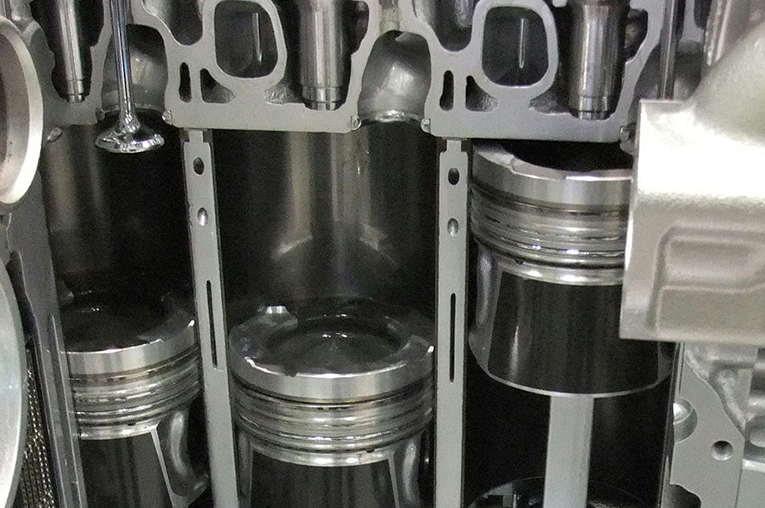Manufacturers make piston rings based on their functionality and usability. Thus, differing in their purpose, there are three types of pistons. The primary function of the piston is to seal the combustion chamber of either a 2-stroke or 4-stroke engine.
The piston rings form an integral part of the piston. And the numbers and functionality depend on the type of engine and its capacity.
For example, a 2-stroke engine has only two piston rings, one for compression and the other, wiper ring. However, the 4-stroke engine has three piston rings. The other ring is the oil scraper ring.
This article has everything related to the triple purpose of the piston rings in a 4-stroke engine.
What Is a Piston Ring?
Piston rings are metallic split-type rings. These are fitted into the grooves in a piston’s outer diameter. They ensure a good seal is maintained between the cylinder wall and piston.
What are Piston Rings Made of?
The most commonly used material for the rings is fine-grained alloy cast iron. While the most common alloys used are nickel, copper, vanadium, chromium, titanium, and molybdenum.
The reason is that cast iron has graphite; thus, it has self-lubricating properties. This creates less friction between the cylinder liners and rings. Also, the piston ring material must be more rigid than the cylinder liner for maximum life. Therefore, the above alloys further strengthen piston ring cast iron.
Many manufacturers also use pressed steel for making rings.
Ring Coating
Piston rings wear out quickly due to frequent loading conditions and high temperatures. Thus, rings are coated with various coatings.
Soft substances like graphite, phosphate and iron oxide are preferred for ring coatings. They also have good oil-absorbing qualities. They soak oil quickly, thus improving ring lubrication.
They also prevent ring scuffing. Scuffing results when metal-to-metal contact occurs at high temperatures. It is pretty similar to welding. Coatings prevent scuffing as there is no exposed iron, and welding doesn’t happen.
What Are the Types Of Piston Rings?
There are two basic types of piston rings:
- Counter Bored and Scrapper Rings Compression Rings
- Oil Control Rings
#1. Compression Rings
Generally, two to three compression rings are present on the piston. The number of rings is related to the compression ratio. Mostly, the 2nd and the 3rd rings are taper-faced. This overcomes the ring-sticking issue of high-power engines.
Counterbored, and scrapper rings are primarily used for the top and second compression rings. These rings tend to twist slightly during the suction stroke. This happens to owe to the internal forces produced by cutting away the corner rings.
During the compression stroke, the rings also move upward when the piston moves upward. In doing so, they tend to stake on the oil film inside the cylinder wall. This reduces the amount of oil delivered to the combustion chamber.
And in the power stroke, combustion causes pressure, which untwists the rings. This results in complete contact with the cylinder walls and optimum sealing.
#2: Oil Control Rings
In some engines, the inside connecting rod splits some oil in each revolution from the oil pan. As a result, more oil reaches the cylinder than required. This excess oil must be scrapped off and turned back into the oil pan, or it will reach the combustion chamber and burn. This will lead to increased oil combustion, and the engine will require frequent oil filling.
Thus, oil removal is essential to cooling, clearing, and sealing inside cylinder walls.
Oil rings are of three types:
- One Piece Slotted Cast Iron Type:
This type of cylinder has slots between the lower and upper faces of the cylinder. The expander spring is responsible for increasing the pressure of the ring on the cylinder wall. This improves the scrapping effect. - One Piece Pressed Steel Type:
These rings are primarily used in an engine’s worn cylinder walls. It’s steel and can seal one of the groove’s sides. - Three Piece Steel Rail Type With Expander:
These seal from both upwards and downwards. And thus provide a much more effective seal.
What Are the Functions of The Piston Rings?
There are 3 primary functions of a piston ring. Let’s have a look at all of them one by one:
#1. Seal for Combustion Gas
This function involves maintaining airtightness in-cylinder, i.e., between the cylinder wall and piston.
It does not let the combustion gas leak from between the piston and cylinder when the explosion creates a gap. If combustion gas leaks, the engine cannot realize full power, leading to increased fuel consumption. This is not good both economically and environmentally.
#2. Control Lubrication Oil Or The Engine Oil
The following function is to keep creating a minimum lubricating oil layer that prevents burn.
Inside the engine’s cylinder, the piston ring goes through high-temperature combustion gas, which happens thousands of times every minute.
Thus piston rings ensure that the cylinder and piston ring don’t burn and that the lubricating oil does not get inside the combustion chamber. For the same reasons, the lubricating oil layer of the cylinder wall is kept at the minimum possible.
#3. Heat Conduction Function
The third function releases heat from the piston to the cylinder.
When gas explodes in the combustion chamber, the temperature reaches 300 degrees centigrade. This excessive heat poses the risk of engine damage. And thus, it needs to be released. The piston rings help us achieve the task.
#4. Piston Attitude Support
This last function prevents the piston from making strong contact with the cylinder wall.
Say, the piston is at an angle, and as it moves up and down, it makes direct contact with the cylinder wall. This can cause engine damage. Piston rings ensure the piston works smoothly.
Conclusion
Thus, piston rings are basically of three types: counter bored and scrapper rings compression rings, and oil control rings. And these rings have multiple functions. They act as a seal for combustion gas, keep a cap on lubricating oil in the combustion chamber, perform heat conduction, and lastly prevent piston from making strong contact with the cylinder.
We hope you liked our information on the various types of piston rings.

A top ranking student throughout, Akshay joined the family business right after graduation in 2006. After working for over 10 years in Agra Engineering Co, he decided to start his own company. Now as a partner in this new company he looks after business development and vendor management. A keen fitness enthusiast he tries new forms of exercise – crossfit, calisthenics, pilates, yoga and swimming. He’s an avid golfer as well – one of his many hobbies.







